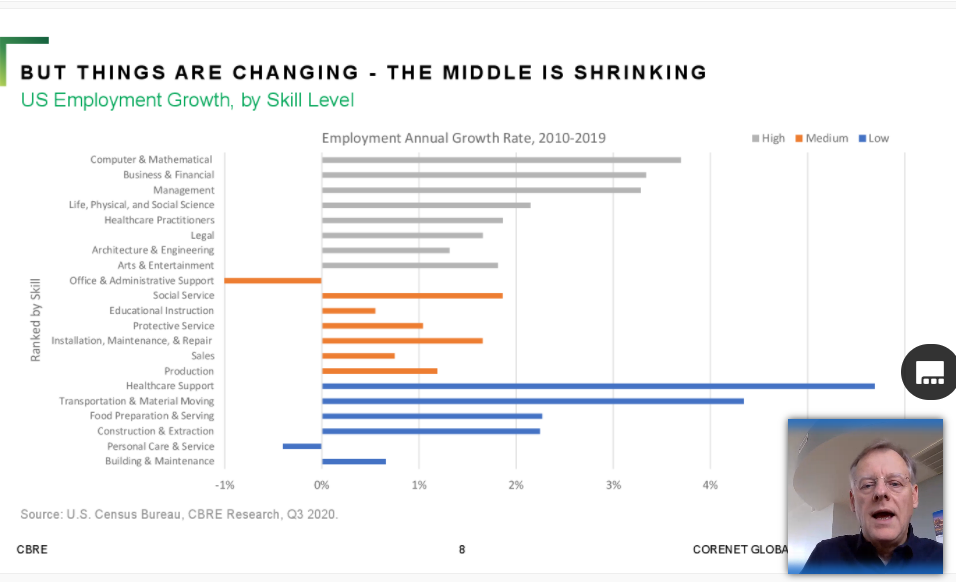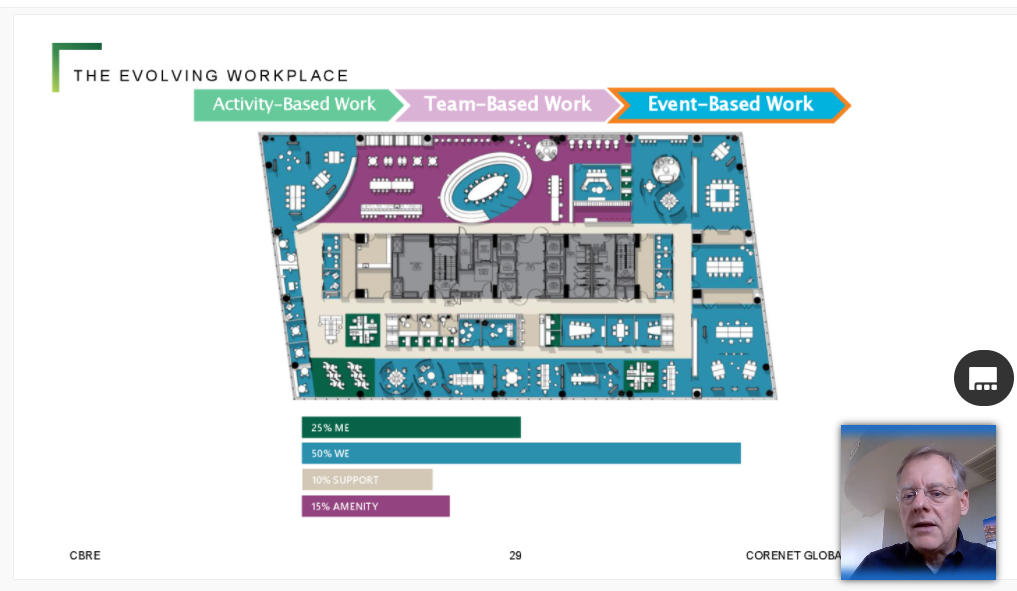How the ‘Shrinking Middle’ Is Impacting the Office Market
At CoreNet Global’s Virtual Summit, Richard Barkham of CBRE explained why mid-level jobs are disappearing and how the trend is changing the workplace.
White collar office jobs have had a profound impact on the U.S. office market over the last 50 years, driving millions of square feet of commercial real estate development. It’s been driven by a surge in service sector employment, which has led to office development and the revitalization of downtown environments.
READ ALSO: Amid Office Changes, Workplace Strategies Are Evolving
But as the sector has grown, more jobs have been added in the highest skilled and the lowest skilled categories, leading to a squeeze in middle-ranking jobs like office and administrative support positions. At CoreNet Global’s Virtual Summit Oct. 27, CBRE Global Chief Economist & Head of Americas Research Richard Barkham delved into why the middle is shrinking and how the trend is changing and will continue to change the workplace.
To understand why job growth has stalled in the middle, Barkham pointed to some key factors:
Big tech
The tech sector’s dramatic growth over the last 15 years has created a huge demand for highly skilled workers. According to Barkham’s research, half of the top 20 firms in the world with the highest spending on research and development are based in the U.S. To put it another way, the U.S. has 4 percent of the world’s population, but 50 percent of the firms with the highest spending on R&D.
“The U.S. tech sector is now worth more than all European stocks,” said Barkham. In August, Bank of America said in a note to clients that U.S. tech stocks were worth $9.1 trillion, surpassing all European stocks, which were worth $8.9 trillion.
The rise of automation
According to the World Economic Forum’s 2020 Future of Jobs Survey, the time spent on current tasks at work by humans and machines will be equal by 2025. Among business leaders surveyed by WEF, just over 80 percent reported that they are accelerating the automation of their work processes and expanding their use of remote work. Additionally, 50 percent of respondents also indicated that they are set to accelerate the automation of jobs in their companies.
“We know it’s happening but when you look closely at the data, it’s even more impressive, even more considerable than you first think,” said Barkham. “Even coordinating, developing and managing will increasingly be done by machines as we move through the next decade.”
Job outsourcing
Many middle-ranking jobs are being outsourced to other countries, like India, which has experienced an explosive job growth since 2000. According to data from CBRE, more than 250 million square feet of office space was leased in the country between 2015 and 2019, 60 percent of which was from global occupiers across various tenant sectors.
“A key part of the shrinking middle argument is that jobs are being outsourced to lower cost locations,” said Barkham. While some still exist in the U.S., they are often moved to lower cost areas of the country like suburban Atlanta, Ga.
“No company can afford to ignore it,” said Barkham of outsourcing. “It brings profound benefits to cost conscious companies.”
Implications for the future
All these factors have led to the nature of work changing. Workplaces are becoming more entrepreneurial and intrapreneurial, according to Barkham.
“Routine doesn’t exist anymore, only change,” he said. “High skill workers are responsible for finding work within and without their own organizations. Intrapreneurial means entrepreneurial within the company: Finding work, creating teams and managing complex teams within the company.”
Barkham sees workplaces as currently in flux and moving to more team-based work. While large numbers of people are still working from home due to the pandemic, further accelerating a trend toward remote work, Barkham predicts that after a period of repricing, big cities in America will “take off again” and still draw talented, highly skilled workers.
“They will thrive as high amenity collaboration hubs,” he said of cities. “This is the direction we’re traveling, moving away from ‘me’ space and moving toward ‘we’ space and amenity space. I don’t think it stops here. I think we’ve got to think about the next 10 years ahead and think how much further this can go to support really high-skilled, high-dynamic work.”









You must be logged in to post a comment.